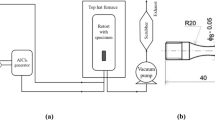Abstract
The surface of anodized parts made of 1163T aluminum alloy that are produced by mechanical treatment of large pressed or rolled semifinished products exhibits dark regions. These regions have a higher electrical conductivity 7 than the rest of the anodized surface, colored light-yellow. Some authors explain the appearance of me dark stains by high-temperature decomposition of the solid solution, which is initiated by secondary heating of these surface regions due to the heat of surrounding volumes in random interruptions of the cooling process. The aim of the present work is to refine the dependence of γ on the endurance in tests for low-cycle fatigue of specimens from seminifinished products made of 1163 alloy in order to establish the intensity of the decrease of the endurance and the admissible increase of γ in the region of dark stains.
Similar content being viewed by others
References
A. I. Golubev,Anode Oxidizing of Aluminum Alloys [in Russian], Izd, Akad. Nauk SSSR (1961).
V. G. Davydov, S. L. Tsukrov, V. V. Zalcharov, et al., “Special features of the decomposition of the solid solution of alloy D16 in quenching with repeated heating,”Metalloved Term. Obrab. Met., No. 6, 3–6 (1993).
S. L. Tsukrov and L. N. Paskhin, “Effect of repeated heating in quenching of sheets from alloy D16,”Metalloved Term. Obrab. Met., No. 12, 16–18 (1991).
V. G. Davydov, V. V. Zakharov, E. D. Zakharov, et al.,Diagrams of Isothermal Decomposition in Aluminum Alloys [in Russian], Metallurgiya, Moscow (1973).
V. V. Teleshov, V. I. Kuzginov, O. M. Sirotkina, et al., “Effect of the structure of crack formation and failure of industrial alloys of the system aluminum-copper-magnesium under conditions of low-cycle fatigue,”Probl. Prochnosti, No. 1, 43–49 (1990).
K V. Tekshov, V. I. Kuzginov, L. A. Gorskaya, et al., “Resistance to low-cycle fatigue and mechanical properties in different zones over the thickness of a plate from alloy 1163 in statesT andTl under different quenching conditions,”Tekhnologiya Legkikh Splavov, No. 5, 19–25 (1991).
G. L. Shneider, N. N. Cherkasov, V. I. Smolenstev, et al., “Effect of the conditions of heat treatment on the properties of semifinished products from aluminum alloys,”Metalloved Term. Obrab. Met., No. 8, 53–56 (1984).
V. I. Kuzginov, V. V. Teleshov, and L. A. Gorskaya, “Tests for LCF with determination of the number of cycles before the initiation of a fatigue crack,”Tekhnologiva Legkikh Splavov. No. 5, 59–63 (1991).
V. I. Kuzginov, V. V. Teleshov, and L, A. Gorskaya, “Relation between two stages of low-cycle fatigue of aluminum alloys,”Fiz.-Khim. Mekh. Mater., No. 4, 110–11 (1990).
Yu. M. Vainblat. S. Yu. Klepachevskaya, A. V. Krylova, et al., “X-ray method for investigating the inhomogeneity of deformation in rolled semifinished products,”Zavod Lab., No. 10, 88–89 (1986).
V. V. Teleshov, “Structural inhomogeneity over the thickness of rolled plates from aluminum alloys and anisotropy of their mechanical properties,”Tekhnologiya Legkikh Splavov, No. 8, 6–11 (1981).
Author information
Authors and Affiliations
Additional information
Translated from Metallovedenie i Termicheskaya Obrabotka Metallov, No. 6, pp. 16–19 June, 1995.
Rights and permissions
About this article
Cite this article
Teleshov, V.V., Kuzginov, V.I., Golovleva, A.P. et al. Effect of high-temperature decomposition of the solid solution on the low-cycle fatigue resistance of semifinished products made of aluminum alloy 1163. Met Sci Heat Treat 37, 233–236 (1995). https://doi.org/10.1007/BF01152225
Issue Date:
DOI: https://doi.org/10.1007/BF01152225




